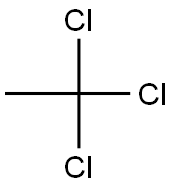71-55-6

Product Name:
1,1,1-Trichloroethane
Formula:
C2H3Cl3
Synonyms:
1,1,1-Trichloroethane in dimethyl sulfoxide;1,1,1-Trichloroethane solution;Methyl chloroform
Inquiry
CHEMICAL AND PHYSICAL PROPERTIES
| Physical Description | 1,1,1-trichloroethane appears as a colorless liquid with a sweet, pleasant odor. May irritate skin, eyes and mucous membranes. In high concentrations the vapors may have a narcotic effect. Nonflammable, but may decompose and emit toxic chloride fumes if exposed to high temperatures. Used as a solvent. |
|---|---|
| Color/Form | Colorless liquid |
| Odor | ... Mild chloroform-like odor |
| Boiling Point | 165.4 °F at 760 mmHg (NTP, 1992) |
| Melting Point | -26.5 °F (NTP, 1992) |
| Flash Point | greater than 200 °F (NTP, 1992) |
| Solubility | less than 1 mg/mL at 68 °F (NTP, 1992) |
| Density | 1.31 at 68 °F (USCG, 1999) - Denser than water; will sink |
| Vapor Density | 4.6 (NTP, 1992) - Heavier than air; will sink (Relative to Air) |
| Vapor Pressure | 100 mmHg at 68 °F ; 125 mmHg at 77 °F (NTP, 1992) |
| LogP | log Kow = 2.49 |
| Henry's Law Constant | Henry's Law constant = 0.0163 atm-cu m/mole at 25 °C |
| Autoignition Temperature | 932 °F (USCG, 1999) |
| Decomposition | When heated to decomposition, it emits irritating gases and toxic fumes of carbon monoxide, carbon dioxide, hydrogen chloride gas, chlorine, and phosgene. |
| Viscosity | 0.00086 Pa.s at 20 °C |
| Corrosivity | Readily corrodes aluminum and aluminum alloys |
| Heat of Combustion | 4700 BTU/LB= 2600 CAL/G= 110X10+5 J/KG |
| Heat of Vaporization | 32.50 kJ/mol at 25 °C |
| Surface Tension | 0.02518 N/m at 25 °C |
| Ionization Potential | 11.00 eV |
| Odor Threshold | Odor Threshold Low: 16.0 [mmHg] Odor Threshold High: 714.0 [mmHg] Detection odor threshold from AIHA (mean = 390 ppm) |
| Refractive Index | Index of refraction: 1.4711 at 20 °C/D |
| Relative Evaporation Rate | 12.8 (Butyl acetate = 1) |
| Kovats Retention Index | 623.5 628 628.6 660 637 637 639 637 640 646 651 650 636 634.6 641 630.7 625.98 636 639 634 634 635.6 639 626 626 634 634 639 621 629 628 634.5 632 650 634 630 |
| Other Experimental Properties | Percent in saturated air: 16.7 at 25 °C |
| Chemical Classes | Solvents -> Chlorinated Aliphatics |
SAFETY INFORMATION
| Signal word | Warning |
|---|---|
| Pictogram(s) |
 Exclamation Mark Irritant GHS07 |
| GHS Hazard Statements |
H420:Hazardous to the ozone layer |
| Precautionary Statement Codes |
P502:Refer to manufacturer/supplier for information on recovery/recycling |
COMPUTED DESCRIPTORS
| Molecular Weight | 133.40 g/mol |
|---|---|
| XLogP3 | 2.4 |
| Hydrogen Bond Donor Count | 0 |
| Hydrogen Bond Acceptor Count | 0 |
| Rotatable Bond Count | 0 |
| Exact Mass | 131.930033 g/mol |
| Monoisotopic Mass | 131.930033 g/mol |
| Topological Polar Surface Area | 0 Ų |
| Heavy Atom Count | 5 |
| Formal Charge | 0 |
| Complexity | 26.4 |
| Isotope Atom Count | 0 |
| Defined Atom Stereocenter Count | 0 |
| Undefined Atom Stereocenter Count | 0 |
| Defined Bond Stereocenter Count | 0 |
| Undefined Bond Stereocenter Count | 0 |
| Covalently-Bonded Unit Count | 1 |
| Compound Is Canonicalized | Yes |
PRODUCT INTRODUCTION
description
1,1,1-Trichloroethane is a synthetic chemical that does not occur naturally in the environment. It also is known as methylchloroform, methyltrichloromethane, trichloromethylmethane, and trichloromethane. Its registered trade names are chloroethene NU® and Aerothene TT®.
